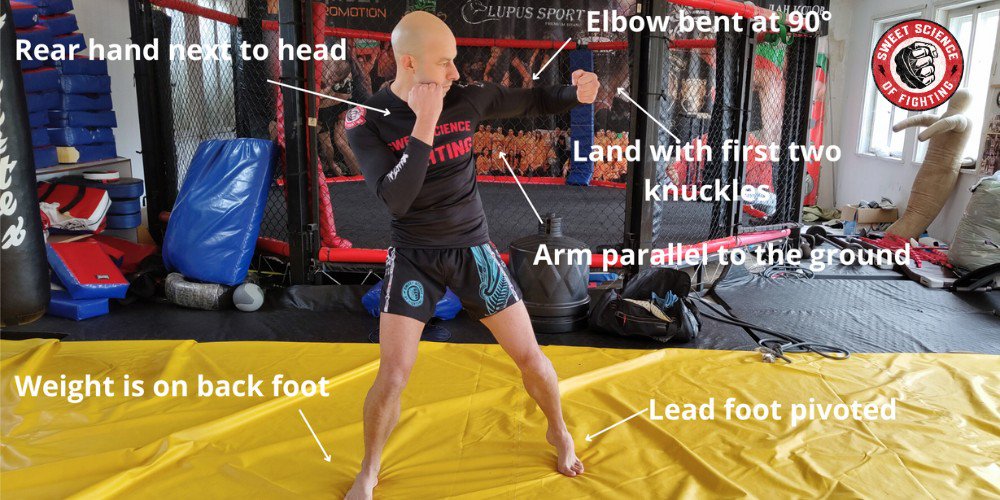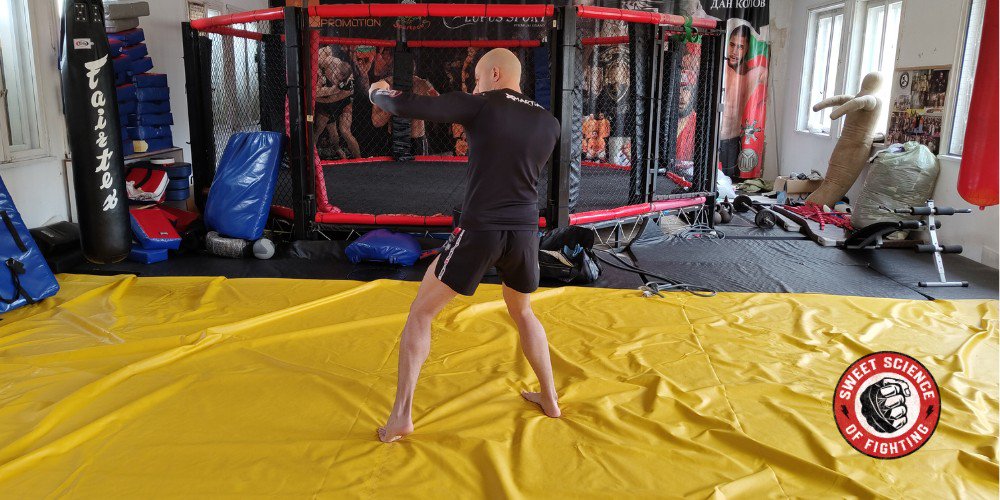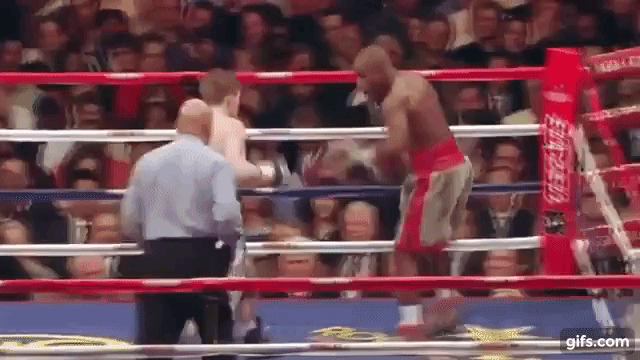The hook is a powerful punch that can be thrown with either hand and is one of the six basic punches in boxing (jab, cross, lead, rear hook, and lead and rear uppercut).
Usually aimed at the side of the head or jaw, hooks can generate tremendous power and are versatile punches used for a variety of purposes.
A hook thrown with the front hand is naturally called a lead hook, and the one thrown with the back hand is called a rear hook.
Hooks are fundamental, and you need to know how to throw a hook, what to avoid when doing it, and how to set it up to maximize your chance of landing.
Thumb Position When Throwing A Hook

I want to start with the thumb positioning when throwing a hook, as this is a common question that causes debates. The two options are to punch with the thumb facing upwards or the thumb facing sideways and the palm facing down.
Discover The Little Known Secrets For Unlocking Devastating KO Power!
Heavy hands are built doing these things...
Which one is correct? Both.
Palm Facing Down Hook
Throwing the hook with the palm facing the floor is the “textbook” way of executing this punch in boxing.
This variation is better when throwing a long lead hook because the rotation of the hand adds a little extra distance to the punch.
A hook with the palm facing down is also better in amateur boxing, where the rules about hitting with the inside of the gloves are less forgiving.
The rotation also helps lift the shoulder for protection against counterattacks and makes it easier to contact the first two knuckles.
Thumb Up Hook
However, many boxers prefer the thumb-facing-up variation because there is less wrist, elbow, and shoulder rotation, and the punch feels more natural.
This also makes the hook quicker, and there is less chance of injuring the wrist punching this way. If you watch professional boxers, you will see the thumb-up variation is much more commonly used.
With that out of the way, let's see how exactly to throw the hooks with both hands.
How To Throw A Lead Hook


Like with all punches, the key to a strong hook is learning how to effectively put your weight and power behind the punch.
Unlike straight punches, which do get some of the power from the arm, a strong hook relies almost exclusively on body rotation, which is why you need to transfer the power from the foot, through the hips, into the elbow, and ending in the knuckles.
The elbow needs to be in line with the fist because it guarantees maximum power delivery and a hard punch.
How To Throw A Rear Hook
The mechanics of the rear hook are the same as the lead one. The position of the striking hand is the same, and the same principles apply.
The critical difference is that the lead foot must be firmly planted on the ground while the rear foot is pivoted simultaneously with the strike.
In the lead hook, you transfer the weight from the lead to the rear foot and do the opposite for a rear hook.
Don't overdo the pivot, though. It's best to rotate no further than 45° (your heel is in line with the opponent).
The rear hook is very powerful, but it's also riskier because it leaves you open to counterstrikes, especially if you overcommit and miss.
How To Throw A Check Hook

The check hook is a lead hook used to counter the opponent’s right hand or their aggressive advance forward.
As such, the key here is to set it up with the proper timing. This is by no means a beginner boxer's move because it’s a high risk and high reward.
There are multiple ways to throw a check hook, but the most common
variation is performed with a fade away or a step back. The fade away or step creates distance to evade an incoming punch, often a jab, and at the same time you throw the lead hook.
Another popular variation of the check hook is performed by pivoting on the lead foot and swinging the back foot around while throwing the lead hook in the same manner we already showed you above.
Ideally, the punch lands on top of the opponent's right hand while also taking you out of danger and putting you at an advantageous angle.
The check hook is not difficult to learn on its own, but landing it in the ring is a whole other story. But master the check hook, and you have a very potent KO ace up your sleeve.
How To Throw A Hook On A Heavy Bag
The heavy bag is the perfect tool to learn how to throw hooks. Experiment with the thumb positioning.
Try landing the hook from close, mid, and long-range. Pay attention to which knuckles are landing, and make sure the elbow and shoulder are behind the strike.
An excellent way to be sure which knuckles are landing and get a complete feel of the hook from different ranges is to do them bare-knuckle.
Of course, do not throw with a lot of power if you are not used to punching without a big glove.
Common Hook Mistakes
Dropping The Guard
The most common mistake when throwing hooks is dropping the guard. Hooks leave your head more open than straight punches, and keeping the non-striking hand close to your head is crucial.
It's common for two fighters to throw lead hooks at the same time, and the rear hand positioning often determines who wins the exchange.
The same goes for the rear hook. Your lead hand should not leave your face while punching with the rear hand.
Elbow Is Too Low
Another common mistake is that the elbow is too low. If the elbow is not behind the fist, the punch won’t have sufficient support when it lands and will be significantly weaker.
Swinging Wildly
In the heat of battle, fighters often start swinging recklessly, which is a mistake. A good hook starts from the guard and is finished after the hand returns to its starting position.
Overcommitting to a hook and missing will leave you out of balance and open for easy counterattacks.
Another common mistake when you want to punch as hard as possible is to wind up or overload the hook.
The exaggerated motion is easily read by the opponent and severely limits the chance of the punch landing.
How To Set Up A Hook
Being able to land hooks is more important than having an ideal technique. After all, the goal of a punch is to land into an opponent, not simply demonstration, which is why setups and timing are crucial.
The lead hook is a tremendous counterattack weapon. It can be used after a blocked punch, after an evaded one, or as a check hook.
As an offensive weapon, the lead hook can be used on its own, while the rear hook is almost always a follow-up in a combination.
Numerous possible setups maximize the chance of landing while remaining reasonably safe, but we'll look at a few basic ones.
Jab-Rear Hook
The jab can be used to set up every other punch in the book. The most basic setup is the jab-right hook.
The jab’s purpose is to gauge the distance to the opponent and occupy his attention before the rear hook finds its target.
This setup works better if you first throw a few right straights because the opponent starts to expect a straight punch and will be surprised by the hook.
After The 1-2
The 1-2-3 is THE fundamental 3-piece boxing combination, and it consists of a jab-right straight and a left hook. The jab finds the range, and the right straight brings the opponent's guard in front and rotates your body perfectly to load the left hook.
The hook becomes powerful due to the torque, and if the opponent blocks the first two straight shots, it's more difficult for him to defend the hook that comes from the side.
Disguised As A Jab
If you've managed to establish a jab, a good way to land a lead hook is to pretend to throw a jab and change it to a hook mid-punch.
Observe the opponents' reactions to your jab, and if you notice your opponent overreaches to parry, you can be confident that a hook will find its target if you change the trajectory in mid-air.
Summary
The hook is a fundamental punch in boxing and every other striking combat sport. Many great boxers have made their careers based on a strong lead hook used as an attack and a vicious counterstrike.
With this guide, you now know all the basic information on how to throw a hook, and all that is left is to double down on the training.

